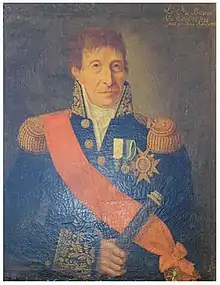Paul-Jacques de Bruyères-Chalabre
Paul-Jacques de Bruyères-Chalabre (Castelnaudary, 25 May 1734 — Chalabre, 6 July 1821)[1][2] was a French Navy officer. He notably captained the 74-gun Illustre at the Battle of Trincomalee from 25 August to 3 September 1782 [3] and at the Battle of Cuddalore on 20 June 1783. [4]
Paul-Jacques de Bruyères-Chalabre | |
|---|---|
 | |
| Born | 20 May 1734 Chalabre |
| Baptised | 27 May 1734 |
| Died | 6 July 1821 Chalabre |
| Occupation | Officer in the French Royal Navy |
| Awards |
|
| Titles | count |
Biography
Bruyères was born to the family of Count de Bruyères Chalabre. He joined the Navy as a Garde-Marine on 11 February 1751, and was promoted to lieutenant on 1 October 1764, and to captain on 4 April 1777.[2]
With the rank of captain, Bruyères commanded the 80-gun Tonnant in the Yorktown campaign. He later captained the 74-gun Zélé and was part of the French blockade during Siege of Savannah in 1779.[5] His role in the War of American Independence earned him a membership in the Society of the Cincinnati.[5]
He then took part in the Indian Ocean campaign under Suffren, commanding the 74-gun Illustre at the Battle of Trincomalee from 25 August to 3 September 1782, [3] where he was wounded. [6] Suffren made flattering reports on his conduct in the battle. [7] He went to fight at the Battle of Cuddalore on 20 June 1783. [4]
After the Peace of Paris put an end to the war in 1783, he returned to France in 1784. He was amongst the captains that Suffren recommended for promotion[8][Note 1] He received a 600-livre pension in recognition of his service.[9] On 1 May 1786, he was promoted to Chef de Division.[5][2]
Bruyères resigned from the Navy on 15 March 1792.[2] During the Reign of Terror, he was arrested, but was released after the Thermidorian Reaction. He then fled France to become an émigré.[5]
After the Bourbon Restauration, Bruyères-Chalabre returned to France. On 13 June 1814, he was promoted to rear admiral. In December 1814, he became a vice-admiral.[5]
From November 1815, he served as a Deputy for Aude in the Chamber of Deputies.[5]
Notes
- The list comprised d'Aymar, Bruyères, Clavières, Du Chilleau, Saint-Félix, Cuverville, Vignes d'Arrac and La Règle.[8]
References
- "Paul Jacques Louis Gabriel BRUYERES CHALABRE". Parcours de vie dans la Royale. Retrieved 27 April 2020.
- Lacour-Gayet (1910), p. 613.
- Cunat (1852), p. 217.
- Cunat (1852), p. 301-302.
- Gardiner (1905), p. 121.
- Cunat (1852), p. 235.
- Cunat (1852), p. 230.
- Lacour-Gayet (1910), p. 550.
- Lacour-Gayet (1910), p. 660.
Bibliography
- Cunat, Charles (1852). Histoire du Bailli de Suffren. Rennes: A. Marteville et Lefas. p. 447.
- Gardiner, Asa Bird (1905). The order of the Cincinnati in France. Rennes: The Rhode Island state society of Cincinnati. p. 121.
- Lacour-Gayet, Georges (1910). La marine militaire de la France sous le règne de Louis XVI. Paris: Honoré Champion.
External links
- "Amiral entre océans et Révolution : Paul-Jacques comte de Bruyères-Chalabre (1734-1821)". autour de nos ancêtres. 20 June 2017. Retrieved 27 April 2020.